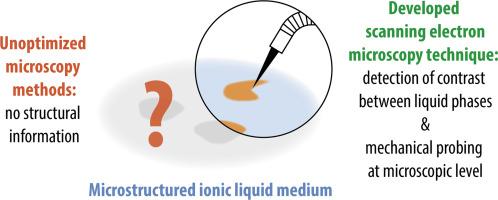Direct method for microscale manipulation at liquid-liquid interfaces in ionic liquid media with real-time electron microscopy observation
引用次数: 0
Abstract
A deep understanding of the processes in soft matter systems with liquid-liquid phase boundaries is of particular importance for materials science, chemistry and life sciences. A vast variety of physicochemical techniques have been proposed for the study of interfacial properties of liquid systems. Among them, electron microscopy methods occupy an important place due to the possibility of direct observation of the sample areas of interest with high spatial resolution; however, the harsh conditions of the electron microscope chamber impose significant restrictions on the possibilities of observing and manipulating unprotected liquids and related soft systems. To overcome these difficulties, in this work, we developed a methodology for direct probing of liquid-liquid interfaces with simultaneous control of the process using electron microscopy. Practically relevant liquid mixtures based on vacuum-compatible ionic liquid (IL) with water additives were probed with micrometer accuracy in real time inside an electron microscope chamber, which made it possible to reveal the role of specific ions aggregation and electrostatic phenomena in the stabilization of liquid microdomains. To test the versatility of the proposed approach, the morphology of a typical IL/water mixture was examined using a series of electron microscopes of various configurations, and it was shown that the best level of contrast between two chemically related liquid phases can be obtained in the case of a cold field emission electron source in combination with an in-lens secondary electron detector, regardless of the specific instrument manufacturer.

利用电子显微镜实时观测离子液体介质中液-液界面微尺度操作的直接方法
深入了解具有液-液相界的软物质系统的过程对于材料科学、化学和生命科学尤为重要。为研究液体系统的界面特性,人们提出了多种物理化学技术。其中,电子显微镜方法占据了重要地位,因为它可以直接观察感兴趣的样品区域,并具有很高的空间分辨率;然而,电子显微镜室的苛刻条件对观察和操作未受保护的液体和相关软系统造成了很大限制。为了克服这些困难,在这项工作中,我们开发了一种直接探测液-液界面的方法,同时利用电子显微镜对这一过程进行控制。我们在电子显微镜室内对基于真空兼容离子液体(IL)和水添加剂的实际相关液体混合物进行了微米级精度的实时探测,从而揭示了特定离子聚集和静电现象在稳定液体微域中的作用。为了测试所提议方法的通用性,使用一系列不同配置的电子显微镜对典型的IL/水混合物的形态进行了检测,结果表明,无论具体的仪器制造商是谁,冷场发射电子源与镜头内二次电子探测器相结合的方法都能获得两种化学性质相关的液相之间的最佳对比度。
本文章由计算机程序翻译,如有差异,请以英文原文为准。
求助全文
约1分钟内获得全文
求助全文

 求助内容:
求助内容: 应助结果提醒方式:
应助结果提醒方式:


